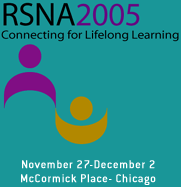
Abstract Archives of the RSNA, 2005
Rod Gibson MBChB , Presenter: Nothing to Disclose
Michael David Spencer MBBCHIR, Abstract Co-Author: Nothing to Disclose
Peter Keston MD, Abstract Co-Author: Nothing to Disclose
William J Moorhead PhD, Abstract Co-Author: Nothing to Disclose
Peter Hoare, Abstract Co-Author: Nothing to Disclose
Stephen M Lawrie MD, Abstract Co-Author: Nothing to Disclose
Eve C Johnstone MBCHB, Abstract Co-Author: Nothing to Disclose
et al, Abstract Co-Author: Nothing to Disclose
This study aimed to characterise the spectrum of structural anomalies of the brain in adolescents with mental retardation, and to establish any relationship between the observed anomalies and the degree of mental retardation. The objective was to clarify the neural basis of mental retardation.
150 adolescents receiving educational support and 50 controls underwent MR brain imaging; subjects aged 13-22 years receiving educational support for learning disabilities were recruited from 99 schools and colleges of education in Scotland. Exclusion criteria were severe cerebral palsy, severe learning disability, lack of speech, known brain injury and Down syndrome. IQ assessments were performed using the WISC-R for subjects under 16 years of age or the WAIS-R in the case of subjects over 16 years of age. Obstetric records were reviewed for pre- and peri-natal adverse events.
MRI studies were assessed by two neuroradiologists (RG, PK) experienced in paediatric neuroimaging who were blinded to clinical details and group membership. Volume images were assessed on multiplanar rendering software.
The scans were assessed in a qualitative fashion, applying a checklist of brain anomalies.
36 features were defined as normal, moderately abnormal, or markedly abnormal and were scored as 0, 1 or 2 respectively. Total abnormality scores were calculated as the sum of scores for all checklist items. All of the studies were assessed for interobserver agreement.
Initial analysis has shown that IQ was negatively correlated with total abnormality scores. Subjects with an IQ less than 70 had a significantly greater total score and a significantly greater score for 12 specific anomalies, including thinning of the corpus callosum and abnormalities of the lateral ventricles.
Good correlations were obtained for interobserver agreement on the total abnormality score and the entire checklist respectively.
Mental retardation is associated with demonstrable brain anomalies, particularly thinning of the corpus callosum and ventricular abnormalities, and with a high total abnormality score. Evaluation of MR scans using the checklist generated resulted in a high degree of interobserver agreement.
Gibson, R,
Spencer, M,
Keston, P,
Moorhead, W,
Hoare, P,
Lawrie, S,
Johnstone, E,
et al, ,
Appearance and Incidence of Brain Anomalies in Mental Retardation: A Qualitative Controlled Assessment of 150 Adolescents. Radiological Society of North America 2005 Scientific Assembly and Annual Meeting, November 27 - December 2, 2005 ,Chicago IL.
http://archive.rsna.org/2005/4411006.html

